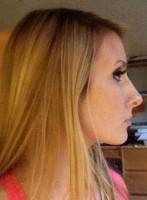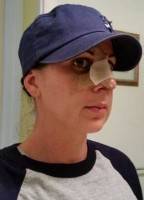Rhinoplasty realistic expectations
Reasonable expectations for Rhinoplasty
A reasonable expectation for this procedure as far as length of surgery, recovery time, functional and aesthetic outcome (ie appearance) will be discussed in a complete consultation with your facial plastic surgeon.
Computer imaging along with seeing pre and post op results will be most helpful. You should allow 6 to 12 months for final results, in general, although some improvement will be evident much earlier; even when the external splint is removed, in many cases. (Harrison C. Putman III, MD, Peoria Facial Plastic Surgeon)
Rhinoplasty is a good procedure to improve the appearance of the nose. The results should last a lifetime. Expect to be in a nasal splint for about a week and bruising for 1-2 weeks. (Steven Wallach, MD, Manhattan Plastic Surgeon)
Rhinoplasty experiences vary with the patient and the surgeon.
In more than 30 years of rhinoplasty experience, I have heard many disturbing patient experiences. This is not the norm! This should be a straight forward, relatively pain free or minimal pain, 1 week off work, etc. Seek out a qualified surgeon and ask to speak to his patients about their experience with the surgeon. (Toby Mayer, MD, Beverly Hills Facial Plastic Surgeon)
Rhinoplasty surgery expectations
Very generalized question that has been quite adequately answered here. I recommend you see 3 boarded rhinoplasty surgeons so you can receive an in detail summary of the ‘what to expect’ issue. (Darryl J. Blinski, MD, Miami Plastic Surgeon)
Rhinoplasty and What to Expect
Rhinoplasty is a permanent surgical procedure, so the results should last your lifetime. The most important aspect of your rhinoplasty is choosing an experienced and skilled rhinoplasty specialist whom you can trust with your nose. Rhinoplasty is considered the most difficult of all facial plastic surgical procedures.
Everything about your proposed surgery should be explained to you by your surgeon at your consultation and again at your pre-operative appointment. You should have pre-operative lab work and surgical clearance from an internist if indicated.
On the day of surgery at our office, your anesthesiologist and nurse will ask you a few questions before taking you into the operating room suite. Once you lay down on the bed, you are made comfortable by the nursing staff with pillows and warm blankets. Once the monitors for your heart, blood pressure, and oxygen level are in place, the only uncomfortable thing that you feel is the small amount of numbing medicine that the anesthesiologist injects next to a vein in you hand.
The I.V. is then placed painlessly. At this point the anesthesiologist gives a little medicine in the IV that makes you feel very good (“Just Say NO to Drugs, except in the operating room), then you are off to pleasant dreams and sleep.
Our anesthetists usually use a medication called Diprovin (made famous by Michael Jackson, but in our center only board certified anesthesiologists administer the medication) and once you are asleep they place a laryngeal mask (LMA) to facilitate giving you oxygen to breathe, and the LMA also protects from any fluid going down your throat.
Next thing you know, you are waking up in the recovery room with tape and splint on your nose. Depending on what needed to be done to your nose, your operation may last anywhere from 1 to 3 1/2 hours. I prefer to not place post-operative “packing” into the nose. If you ask patients who have had rhinoplasty,”What was the worst thing about your rhinoplasty?”, if they had packing in their nose for a few days, they will say, “The packing!”
After about one hour, once you are fully awake, you are allowed to go home. Once you are home, we recommend that patients get into bed with there head elevated up on 3 to 4 pillows so that their nose is elevated well above their heart. Baggies of frozen peas are kept on the bridge of the nose as tolerated.
Surprisingly, our patients seldom complain of pain, but rather a stuffy nose or sinus headache type of pressure that is usually relieved with Tylenol. Patients return to the office two days after surgery to have their nose cleaned of any mucus or dried blood, the nasal passages are suctioned so that breathing is a little better.
The nose will become congested again for a few days. On the fifth day, my favorite, the tape and splint are removed and the new nose is unveiled. Swelling and bruising continue to resolve over the next few days so that patients are quite presentable between 7 to 14 days after surgery. The appearance of the nose should continue to improve over the next 6 to 12 months.
We then see our patients at one week, one month, three months, six months, one year, and then once a year as needed. All patients should be aware that there is usually between a 3% to 10% chance of revision surgery after initial rhinoplasty. (Michael A. Persky, MD, Encino Facial Plastic Surgeon)
What to expect after Rhinoplasty
Your recovery largely depends on the amount of work done on your nose. I assume you are going to have the “works” meaning reducing the hump on your nose, narrowing the bone, refining the tip and straightening the inside of the nose. The surgery usually takes 3-4 hours and you will have a splint on the nose and either nasal packing or splints inside the nose as well.
The splint and packing is usually removed at 7-8 days. Your nose will be swollen for the first 3 months. It usually takes 6-12 months for the nose to reach its final, refined shape.
I recommend my patients refrain from strenuous exercise for the first 4 weeks to minimize any risk of the bone moving. Also glasses should not be worn as they may cause dents and move the bone as well. (Michael A. Jazayeri, MD, Santa Ana Plastic Surgeon)
Rhinoplasty Recovery
All patients looking into rhinoplasty surgery need to be realistic about a recovery period. Even straight forward rhinoplasty procedures result in some swelling, bruising, or drainage. This is normal and should be expected.
External dressings are usually left on for 5-7 days, and are obvious in any public appearance. Therefore plan on at least one week of downtime. If you are a slow healer who bruises easily plan on 10 days. With proper planning rhinoplasty patients won’t be rushed, and recovery will be less stressful.
It is not worth endangering a good result just to have the external splints and/or sutures removed a few days earlier. (Ira D. Papel, MD, Baltimore Facial Plastic Surgeon)
Rhinoplasty & recovery
The recovery depends totally on the surgery performed an this can range from a quick & simple recovery for a tip rhinoplasty to a more complicated & prolonged recovery for a secondary revision with costal cartilage grafts.
In general,some common milestones are removal of stitches between 3-5 days, removal of splint between 5-7 days, gentle low impact activity between 2-6 weeks. (Otto Joseph Placik, MD, Chicago Plastic Surgeon)





